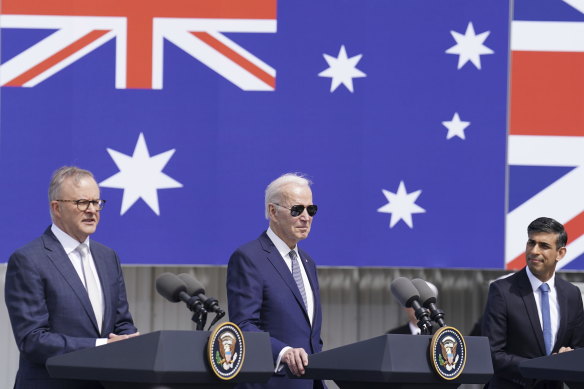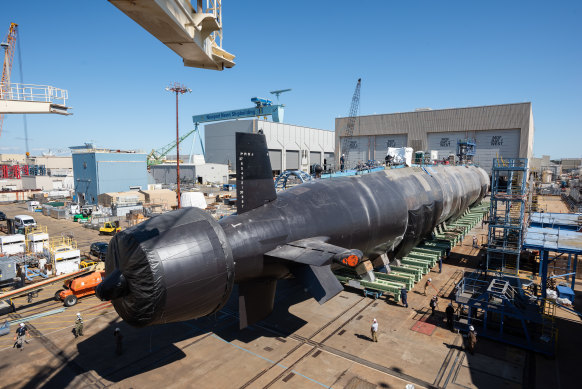Save articles for later
Add articles to your saved list and come back to them any time.
Washington: Australia will be given an exemption from strict US export control laws to help accelerate the delivery of its nuclear-powered AUKUS submarine fleet, under a bipartisan proposal making its way through Congress.
In a boost for the Albanese government, the $368 billion plan to bolster Australia’s defences in the Indo-Pacific moved a step closer to reality on Friday (AEST) after a powerful US Senate committee approved draft legislation designed to turbocharge the ambitious three-way military pact with the US and UK.
Anthony Albanese, Joe Biden and Rishi Sunak at the AUKUS announcement in San Diego in March.Credit: AP
The draft, which was given the green light by the Senate Foreign Relations Committee and is expected to be debated more broadly next week, will help facilitate the transfer of Virginia-class ships under the AUKUS agreement and strengthen the submarine industrial base of the three nations involved.
Australia’s ambassador to the US, Kevin Rudd, said it would also allow America to share its highly sensitive technology secrets by granting Australia a “national exemption” to get through the maze of regulations and export control laws that govern the agreement.
“That’s a necessary precondition for our country’s defence, science and technology base to form a seamless partnership with our American and British friends,” the former prime minister said as he toured shipyards in Virginia with local senator Tim Kaine and Navy Under Secretary Erik Raven.
“The challenges we face today can’t allow us to just do business as usual.”
Unveiled in March by Prime Minister Anthony Albanese, US President Joe Biden and UK Prime Minister Rishi Sunak, AUKUS represents the biggest leap in Australia’s defence capability in history.
Under the plan Australia will buy at least three Virginia-class submarines from the US while building capacity to develop its own locally made nuclear-powered subs, sometime in the 2040s.
The initiative reached a significant milestone last week when three Brisbane submariners became the first group of Royal Australian Navy personnel to graduate from Nuclear Power School, putting them on track to operate the attack subs that will eventually be provided to Australia.
Huntington Ingalls Industries’ shipbuilding yard in Newport News, Virginia.Credit: AFR
“The capacity of a nation to develop strong alliances might be the greatest strategic edge any nation has,” said Senator Kaine, pointing to Russia’s invasion of Ukraine as a cautionary tale.
But while AUKUS has received broad bipartisan support questions remain about the lengthy time frame of AUKUS, the extraordinary cost to taxpayers, and the myriad of rules governing the deal. Among them is the International Traffic in Arms Regulations (ITAR) which could delay for years the transfer of crucial technologies unless the system is reformed or a special waiver is granted.
To that end, the approval by the Foreign Relations Committee, which has jurisdiction over armed export controls and ship transfers, was an important boost for AUKUS, however there is still a long way to go before all the relevant AUKUS legislation makes it through Congress.
Some US politicians have also raised concerns that AUKUS could stretch America’s industrial base “to breaking point”, given the industry was already struggling to meet its target to build two attack submarines a year.
Asked if the US had the capacity to provide Australia with the submarines promised under the pact, Under Secretary Raven replied: “Yeah, absolutely”.
He pointed to $US1.7 billion of new investment passed in the president’s latest budget, which he said would help address US maintenance backlogs, but added: “AUKUS is a big initiative and it’s not the United States – it’s the UK and Australia who have a lot of work to do to make this partnership reality. That includes big lifts on all sides of our oceans.”
Get a note directly from our foreign correspondents on what’s making headlines around the world. Sign up for the weekly What in the World newsletter here.
Most Viewed in World
From our partners
Source: Read Full Article


